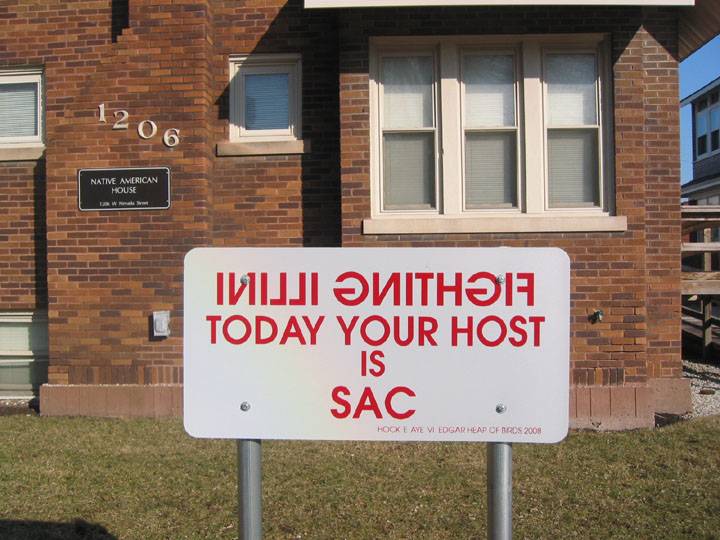
The mob gathers pitchforks and torches.
If Mark Nepermann avoids the death penalty, they’ll see justice done themselves. Afterward, they’ll march to the County Courthouse, pull State’s Attorney Julia Rietz from her comfortable office, and boil her in hot tar.
No published evidence suggests Mark Nepermann knew anything about the sign he pulled from a yard as he staggered home. Perhaps he interpreted its message correctly. Maybe he misinterpreted it. Maybe he is an anti-Chief activist, and wanted to put the sign in his yard. Maybe he’s pro-Chief, and wanted to destroy it. Maybe he just thought it was funny.
But the circling vultures have already determined his mindset: Hate crime.
 WHAT WAS HE THINKING?
WHAT WAS HE THINKING?
As a matter of law, it seems likely that Nepermann had no specific intent regarding the sign he removed from a lawn near the Quad. Given the time of day, his age and the location, one might even conclude that he had been (shock!) drinking.
In Illinois, voluntary intoxication is a defense if the defendant can demonstrate that she or he, as a result of the intoxication, was unable to form the specific intent necessary for the crime. (720 ILCS 5/6-3)
What is a Specific Intent Crime?
It will be plenty hard getting a charge of theft to stick. Theft in Illinois is a crime that involves a heightened level of mens rea. Specifically, you can’t commit a theft without knowing it. “Knowledge” is the second highest level of culpability. It’s easier to prove that a person acted recklessly.
Rietz could have charged a variety of other offenses from the Illinois Criminal Code, but they all have the same “knowledge” mens rea requirement.
(720 ILCS 5/21‑1) (from Ch. 38, par. 21‑1)
Sec. 21‑1. Criminal damage to property.
720 ILCS 5/21‑1.2) (from Ch. 38, par. 21‑1.2)
Sec. 21‑1.2. Institutional vandalism.
(720 ILCS 5/21‑4) (from Ch. 38, par. 21‑4)
Sec. 21‑4. Criminal Damage to Government Supported Property.
“Voluntary intoxication” means you went to a bar, smoked some doobage, or in some way consumed a mood altering substance. The term exists to differentiate “involuntary intoxication,” in which someone slipped you a roofie.
The voluntary intoxication defense is hard to prove in Illinois, especially where defendants have evinced some kind of plan, or awareness of their actions. It’s even harder to achieve with serious crimes. Nepermann’s crime was neither serious (when contrasted with the systematic disemboweling of a loved-one) nor contrived.
WHAT WERE YOU THINKING?
In yesterday’s opinion from the Editors of this publication, Rietz was vilified for charging Nepermann with a misdemeanor, rather than a felony.
In a public statement, Rietz explained that the level of offense is determined by the value of the property stolen. Over $300 = felony. Some people might consider Edgar Heap of Birds’s signs to be worth millions. But you could have one made for $88.65, and that’s the gist of the nub.
Does this mean you could steal a Picasso, and elicit a misdemeanor charge? Yes, it does. If you steal a print of a Picasso made by a third party (as were the signs) you’d likely be charged with misdemeanor theft. Had Heap of Birds hand-carved the sign from a chunk of aluminum, the value would have been less easily ascertained by local police. But they had a receipt from the manufacturer. And that’s the most important thing to know when forming an opinion about Rietz’s mindset. Nepermann and his attorney will have access to that receipt. They can prove to a jury that the sign cost $88.65, and that’s prima facie evidence that Nepermann did not steal something worth over $300.
The most basic distinction between any misdemeanor and any felony concerns time spent in the clink. Misdemeanors = 364 days or fewer. Felonies will tie you up for 365 days to life.
In Illinois, few class 4 felony convictions incur a prison sentence. (The prisons are already overflowing with dope smokers.) So charging Mark Nepermann with a felony would have accomplished no greater punishment. It might have reduced the odds of getting a conviction, though. Juries are somewhat predictable, and no matter how thorough the voir dire, a jury is likely to include someone who thinks “felony” is too grave a mark on the permanent record of a guy who, it will be argued, made a snap decision to grab a yard decoration on his drunken lurch home from a bar. One thing we do know about Nepermann is that he was an Eagle Scout.
Rietz has no way of knowing what the jury will be thinking. She’s unlikely to make an error of overbearing.
QUIT TELLING ME WHAT I’M THINKING
The problem with the Chief/anti-Chief discourse is that either side invariably claims to know the mind of the other. The anti-Chief crowd fired the first shot, claiming anyone wearing Orange and Blue was a racist. The retort claimed activists were communist thought police.
The majority moderates amused and bemused themselves, watching from the sidelines.
More elegant arguments arose. From the anti-Chief side: Studies showed American Indian caricatures had a detrimental effect on the self-esteem of aboriginal youth. From pro-Chief: That’s Chief Wahoo, not our noble Illiniwek, whose regalia and dance were, after all, given to us by the Lakota Sioux.
In the end, the University of Illinois decided no one would be able to divine or distort whatever statement was made by Chief Illiniwek. It simply stopped making the statement.
So now, each side of the Chief fight is left to decipher and translate what the University isn’t saying, or why it doesn’t say what it really wants to say. This makes message control easier for both sides. When one is determined to put words in the mouth of another, it’s best if there are no words there already, as they might conflict with the message.
 As for Mark Nepermann, the most fervent true believers likely don’t care whether the charge is misdemeanor theft or felony theft. They don’t want theft charges. They want a hate crime prosecution. That would require a determination of Nepermann’s perception.
As for Mark Nepermann, the most fervent true believers likely don’t care whether the charge is misdemeanor theft or felony theft. They don’t want theft charges. They want a hate crime prosecution. That would require a determination of Nepermann’s perception.
Julia Rietz is wise. She will not attempt to interpret Mark Nepermann’s thoughts. More importantly, she will not try to persuade twelve persons to unite against Chief Illiniwek. That’s what this case is really about.
Proving Nepermann’s determination to injure “injuns” might be done, but the state would need a whole lot of pictures of Nepermann attending pro-chief rallies, wearing Chief paraphernalia, and possibly war paint. They might present some permissibly accumulated communications (a MySpace blog, for example) in which Nepermann declared his hatred of all things anti-Chief. If such evidence existed, I expect we’d have heard about it. Given the demographic of Champaign County’s jury pool, it might not bring a conviction in the Nepermann case. But it might get him elected.








